Syngonium Care – How to Grow Arrowhead Plant

Syngonium plants are tropical flowering plants that thrive indoors. The attraction of species of Syngonium is their arrow-shaped leaves that can be in shades of green, pink, yellow, or white. The main species of these plants is the Syngonium podophyllum. Also called arrowhead plants, goosefoot, or American evergreen, these vining plants add to the aesthetics of any indoor environment. With proper care, you can also grow these tropical plants at home.
How to care for Syngonium: Arrowhead plants (Syngonium podophyllum) thrive in medium to bright light, but away from direct sunlight. Grow in well-draining soil, water when the potting mix partially dries, keep the temperature between 60°F and 80°F (15°C – 26°C) and humidity over 50%. Fertilize monthly during the growing season.
Arrowhead plants (Syngonium podophyllum) are the most commonly cultivated species from the genus Syngonium. Most people just refer to these houseplants as Syngonium. So, all the names of the different types of plants refer to arrowhead cultivars from the single species. Arrowheads are related to Philodendron plants, which is why they’re also called arrowhead philodendrons.
Arrowhead plants have diamond-shaped leaves growing on trailing vines. In their native environment of tropical rainforests, the climbing plants can grow as tall as 32 to 65 ft. (10 – 20 m). Indoors Syngonium is a fast-growing plant species that grows to between 3 and 6 ft. (0.9 – 1.8 m) and a spread of up to 2 ft. (60 cm).
Although a type of flowering plant, it is rare that syngoniums bloom indoors. Most people grow these tropical plants for their attractive colorful foliage. Some varieties of arrowhead plants have leaves that are dusty pink, others have green with creamy-white variegation, and some have multicolored leaves with shades of green and pink.
Types of Syngonium (Arrowhead Plants)
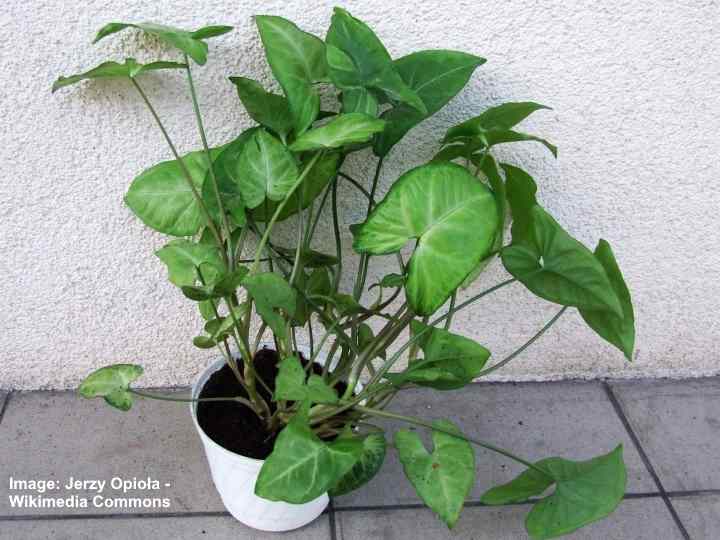
Arrowhead plant has many cultivars. In the picture: Syngonium podophyllum ‘Emerald Green’
Let’s look briefly at some of the most popular varieties of arrowhead plants that grow exceptionally well indoors:
- Syngonium podophyllum ‘Pink Allusion’—This variety of arrowhead has shiny green leaves with hints of pink blushing and pink veins.
- Syngonium podophyllum ‘Strawberry Cream’—The leaves on this arrowhead variety are almost entirely pink, with only hints of green. Grow in bright light for vibrantly-colored leaves.
- Syngonium podophyllum ‘neon robusta’ – Another cultivar with rosy-pink and green foliage which is very easy to care for and looks stunning in any home decor.
- Syngonium podophyllum ‘Imperial White’—This stunning variety has variegated leaves that are dark green and brilliant white. It’s one of the rarest types of arrowhead plant you can find and similar to the ‘Albo-Variegatum’ cultivar.
- Syngonium podophyllum ‘Holly’—Also called Holly Nephthytis, this arrowhead plant has spectacular white leaves with green edging.
- Syngonium podophyllum ‘Berry Allusion’— This easy-to-grow variety of plant has light-green arrowhead-shaped leaves with hints of pink and cream.
- Syngonium podophyllum ‘Painted Arrow’—Another variegated arrowhead plant with brightly-colored creamy-white and green leaves.
How to Care for Syngonium Plants

A cultivar of pink syngonium
Syngonium arrowhead plants are incredibly versatile houseplants that grow in most indoor conditions. You can prune the plant to encourage bushy growth. Or, you can let its trailing vines dangle down over a hanging basket. Arrowhead plants are also vigorous climbers that can grow a few feet up a moss pole to create an attractive visual accent.
Syngonium plants are generally easy to care for indoors. However, there are a few things to get right for your plants to thrive. Read on to find out the best tips for looking after your arrowhead vine plants at home.
Light to Grow Syngonium Indoors
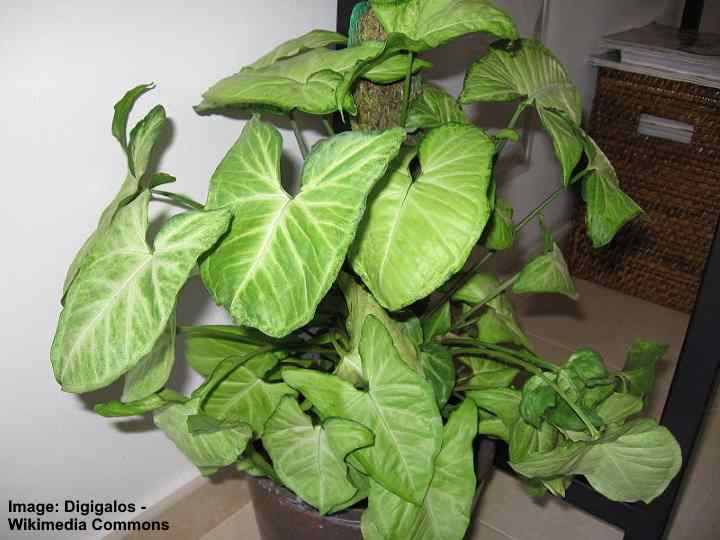
Avoid direct sunlight when growing arrowhead plant
Being a type of non-fussy houseplant, arrowhead plants can grow in low-light or bright light. Usually, arrowheads with light-colored pink, yellow, or white foliage require a room with bright, indirect sunlight. If you have a darker-colored variety, then you can grow the leafy plant in a shaded corner or a room with little light.
Some Syngonium podophyllum cultivars can suffer if the lighting is too low. You can recognize the signs of poor light if the trailing vines become straggly with sparse foliage. You may notice that the plant’s growth slows down, and some of the vibrancy disappears from the leaves.
The other issue when it comes to proper lighting for a Syngonium is direct sunlight. Native to rainforests, arrowhead plants grow as groundcover plants similar to ivy or climb up trees. In any case, they always grow in dappled sunlight. The sun’s rays can scorch the plant’s delicate leaves, causing them to lose their green, pink, and yellow colors.
The best locations to grow Syngonium plants are on an east-facing or north-facing windowsill, or in a west or south-facing room away from the window. Arrowhead plants also make excellent shower plants as they thrive in humid conditions and aren’t fussy about light. You can also grow these plants in hanging baskets in a shaded corner of a room.
How to Water Arrowhead Plants
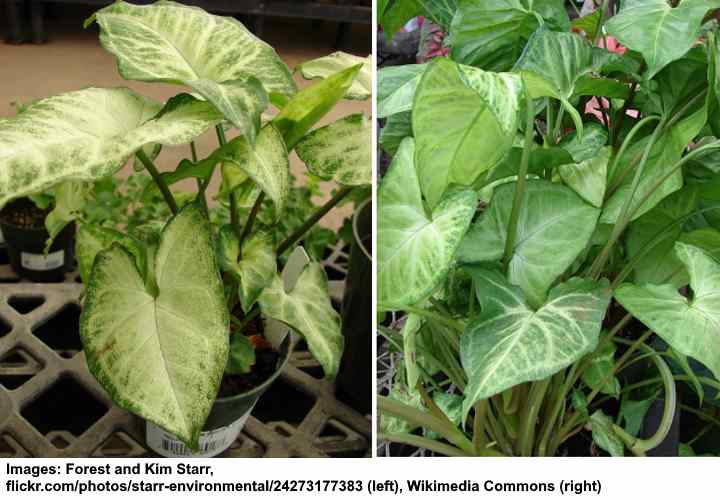
Water your Syngonium plant when the top soil has dried and let the water drain out the bottom
Proper watering is essential to the growth of healthy arrowhead plants. You only need to water the plant as often as the top part of soil dries out. In summer, you may have to water the plant as often as once a week or more frequently. During winter months, when growth slows, water less often.
To tell if arrowhead plants need watering, poke your finger about an inch (2.5 cm) into the soil. If the soil is dry, it’s now time to water your Syngonium plant by giving the soil a good soak. If the potting mix feels damp or moist, hold off watering for a couple of days. The general rule for watering houseplants is to let the top layer of soil dry completely.
The best way to water arrowhead vines is to drench the potting mix. Pour enough water in the pot until it drains out the bottom. This watering technique allows the roots to get hydrated and nourished. If you fail to do that, your plants could show signs of under-watering, even though you are watering them regularly.
Here are some top tips when it comes to watering arrowhead plants:
- Use filtered water or rainwater to water houseplants; otherwise, leave tap water out for 24 hours to allow chemicals to evaporate.
- Always use water that is at room temperature to hydrate plants.
- Avoid watering plants often with only a small amount of water—the roots don’t get nourished, and you risk mold or fungus gnats in the soil.
- Use soil dryness as a guide for when and how often to water arrowhead plants.
The Best Potting Soil for Arrowhead Plants
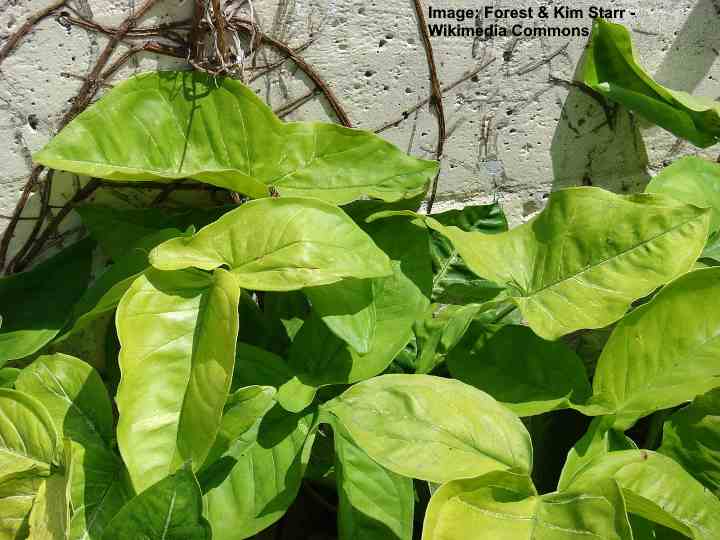
Arrowhead vine thrives in well-drained acidic soil rich in nutrients
Syngonium plants prefer an acidic potting medium with a pH level of between 5.5 and 6.5. The potting soil should be rich in nutrients and have excellent drainage. The worst thing for an arrowhead plant is to sit in overly damp or soggy ground. The ideal potting mix should be a combination of potting soil, peat moss, and perlite.
The ingredients for the perfect potting soil should mimic its native habitat. Organic matter such as peat moss provides essential minerals and nutrients. Peat also helps retain just enough moisture to hydrate the roots. Ingredients such as perlite, charcoal, or bark chippings help keep the soil loose so that it drains better.
A few ways to tell if you need to change the potting soil are as follows:
- The arrowhead plant doesn’t grow as fast as it should.
- Water takes a while to drain out the plant pot’s drainage holes.
- Water gathers on the surface of the potting mix.
- You have to water plants less often because moisture can’t evaporate as quickly.
Later in the article, you will find out how to repot an arrowhead vine with a fresh potting medium.
Temperature Requirements for Syngonium Plants

Arrowhead plants grow well in an even room temperature or outdoors when the temperature is warm enough
Average room temperatures are ideal for arrowhead plants to thrive indoors. Grow your Syngonium plants at an even temperature between 60°F and 80°F (15°C – 26°C). For faster growth, it’s best not to let the room temperature drop below 65°F (18°C). A warm room generally means you have to water the plant more often.
To avoid stressing your plant and causing the leaves to droop, try to avoid temperature extremes. In summer, keep arrowhead plants away from cold drafts, such as open windows or the air-conditioner flow. During winter, don’t place the plant next to hot radiators.
Arrowhead vine plants grow outdoors if the temperature is warm enough. You can use these creeping vines as ground cover for shaded areas if you live in USDA zones 10 through 12. You can also take your plants outdoors during the summer if you are in a temperate climate.
Just remember the following tips about growing arrowhead plants outdoors:
- Put the arrowhead plant pot or hanging basket in a bright location out of direct sunlight.
- Bring the container indoors when the nighttime temperature drops below 60°F (15°C).
- Keep the plants away from pets or children as arrowhead plants are toxic.
Proper Room Humidity Levels for Healthy Syngonium Plant Growth

Syngonium podophyllum needs high humidity levels of at least 50%
When growing tropical plants like Arrowhead (Syngonium podophyllum) indoors, getting humidity levels right is challenging. Houseplants like Syngonium are native to the tropics and need high humidity of at least 50%—but, ideally, 60%. To make indoor conditions more humid, you can mist the plant leaves, sit the plant on a pebble tray, or use a room humidifier.
Here are the best ways to boost humidity so that your Syngonium arrowhead cultivar thrives:
- Misting twice-weekly—Fill a spray bottle with distilled or filtered water. Create a fine mist over the arrowhead plant to gently hydrate the leaves.
- Humidify using a pebble tray—Put a layer of decorative stones in a wide dish that is a few inches deep. Half-fill the tray with water and place the container on the pebbles. Make sure that the bottom of the pot isn’t in direct contact with the water.
- Room humidifier for houseplants—You can easily regulate humidity levels for your tropical plants if you use a humidifier.
- Wipe the leaves—Use a damp cloth to wipe the leaves once or twice a week. The moisture will help to create humidity on the leaves and also clean them from household dust.
How to Fertilize Arrowhead Plants
Fertilize syngoniums monthly with a diluted, balanced houseplant fertilizer. Arrowhead plants are not big feeders and only need a nutrient and mineral boost during the growing season. Don’t feed the plant in the fall and winter because growth is dormant, and the plants don’t need any food.
You can use a water-based, all-purpose plant fertilizer that is diluted by half. Apply the fertilizer every four weeks after watering it. Or, you can use slow-release granules when you repot the plant in spring.
Pruning a Syngonium Plant

Prune your Syngonium plant to control its growth and create a dense appearance
Pruning helps to control the growth of Syngonium plant. When growing the arrowhead plant indoors, the vines can reach up to 6 ft. (1.8 m) in length. Pruning can also help to encourage bushy growth if you want to put the plant on a desk or tabletop. Pruning also helps improve its appearance if the stems have become long and unkempt looking.
Always prune the stems in the springtime when growth is vigorous. Cut above the node to the length you want the stems to grow. New growth will appear at the cut stem. To maintain a bushy appearance, snip off any new stems as they appear.
How to Propagate Arrowhead Vine Plants
Rooting stem cuttings in water is the best way to propagate arrowhead plants. All you need to do is to cut section of the plant close to the roots, making sure there are at least 3 or 4 leaves on it. Place the stem cutting in a jar of water and wait a few weeks for roots to appear. Transfer to a small pot, mist the plant, and place in medium to bright light.
How to Repot All Types of Syngonium Plants

Repot your arrowhead every two years to prevent it from becoming rootbound
You should repot arrowhead plants every other year as they can become rootbound. Transferring to a larger pot encourages faster, healthier growth, and you can check the plant’s roots for signs of disease. You can also divide the plant at its roots if it’s growing too big for your room.
To repot an arrowhead plant, this is what you should do:
- Gently remove the Syngonium plant if from its existing container.
- Remove all the dirt off the roots and untangle them if necessary.
- Choose a new container that is the next size up and half-fill it with potting mix and put your plant in it.
- Fill the remaining space with the potting medium and thoroughly water.
Is Syngonium Plant Species Toxic?
Yes, all parts of arrowhead plants contain poisonous substances. All species of Syngonium contain calcium oxalate crystals. If humans or animals ingest part of the stems or leaves, the results will be gastric irritation, drooling, and oral swelling. So, keep the plant out of reach of children. (1)
The American Society for the Prevention of Cruelty to Animals (ASPCA) says that arrowhead plants are toxic to cats, dogs, and horses. (2)
Pests and Diseases Affecting Arrowhead Vine Plants
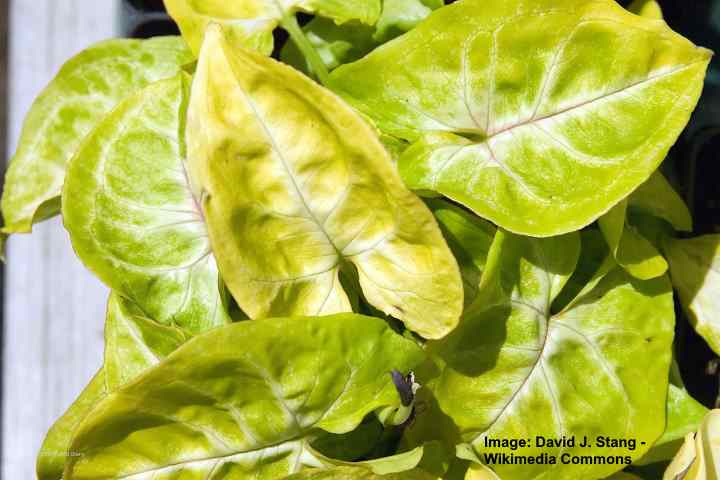
In this picture: Syngonium podophyllum ‘Golden’
Houseplant pests such as spider mites and mealybugs can infest Syngonium plants. Both of these pests can suck the life out of your plant, causing it to wilt and eventually die. You can prevent these common plant pests by keeping humidity levels high.
If you notice signs of pests on your houseplants, try using insecticidal soap to remove them naturally. You can also get more advice in this article on how to get rid of plant pests without chemicals.
Root rot is the most common type of disease that affects the growth of arrowhead plants. You can easily avoid rotting roots by watering your plants appropriately. Only water arrowhead plants when the top 1” to 2” (2.5 – 5 cm) is dry. Then, thoroughly drench the soil. The next time to water the plant is when the soil dries. In summer, this could be as often as every week or more, but in winter, every other month.
Constant damp soil can cause a harmless white mold to appear. Learn how to get rid of white mold on plants.
FAQs on Growing Syngonium Podophyllum (Arrowhead Vines) Indoors

This image shows Syngonium podophyllum ‘Imperial White’
Why are arrowhead plant leaves turning yellow?
Watering issues are usually to blame if your arrowhead vine leaves start yellowing. Too much water or not enough hydration can cause the Syngonium plant’s vibrant foliage to become yellow. Check the soil for moisture levels and adjust your watering schedule appropriately.
Why are brown tips appearing on arrowhead plant leaves?
A lack of humidity can result in brown patches on the Syngonium leaves. To resolve the issue, bump up the humidity levels around the plant. Also, make sure that the arrowhead plant isn’t near air vents or radiators.
How to speed up arrowhead vine growth?
Naturally, arrowhead plants grow slower in the winter. However, if their growth seems lethargic during the growing season, you need to check your care methods. Try moving the Syngonium plant container to a brighter spot and humidify regularly. You could also try repotting the Syngonium podophyllum plant to replenish nutrients and feed with a balanced household fertilizer monthly during the growing season.
Do arrowhead plants flower indoors?
Syngonium podophyllum plants rarely flower indoors. When growing outdoors, syngoniums grow flowers similar in appearance to types of anthurium plants. The arrowhead flowers are made up of spathes—modified leaves—and spike-like flowers similar to other aroid plants.
Related articles:
- The Best Indoor Vine Plants and Climbers
- The Best Bedroom Plants (with Pictures)
- The Best Shower Plants to Keep in Your Bathroom
